District Heating Deployment and Energy-Saving Measures to Decarbonise the Building Stock in 100% Renewable Energy Systems
Abstract
:1. Introduction
1.1. Literature Review
1.2. Scope of the Work and Outline
2. Materials and Methods
2.1. H2RES Model
2.2. Heating Sector in Italy
2.3. District Heating Deployment and Energy-Saving Scenarios
2.4. Technical and Economic Assumptions
| Technology | Units | INV 2020 (M€/Unit) | INV 2030 (M€/Unit) | INV 2040 (M€/Unit) | INV 2050 (M€/Unit) | Efficiency/Full Load Hours | Refs. |
|---|---|---|---|---|---|---|---|
| PV | MW | 0.92 | 0.58 | 0.42 | 0.33 | 1517 | [42,43] |
| On-shore Wind | MW | 1.79 | 1.07 | 0.92 | 0.86 | 2418 | [42,44] |
| Off-shore Wind | MW | 3.22 | 1.93 | 1.66 | 1.59 | 2759 | [42,44] |
| PEMFC CHP | MW | 1.3 | 1.1 | 0.9 | 0.8 | 50% | [45] |
| SOFC CHP | MW | 3.3 | 2 | 1.3 | 0.8 | 60% | [45] |
| Alkaline Electrolyser | MW | 0.65 | 0.45 | 0.3 | 0.25 | 66.5–78 | [45] |
| SOEC Electrolyser | MW | 4.5 | 1.9 | 1.3 | 0.78 | 77–83.5% | [45] |
| PEM Electrolyser | MW | 0.92 | 0.65 | 0.45 | 0.4 | 58–70.5% | [45] |
| H2 Storage (tanks) | MWh | 0.057 | 0.045 | 0.027 | 0.021 | - | [45] |
| Biomass Boiler | MWth | 0.47 | 0.447 | 0.425 | 0.404 | 79–85% | [45] |
| Gas Boiler | MWth | 0.278 | 0.265 | 0.252 | 0.24 | 90% | [45] |
| Centralised HPs | MWth | 1.2 | 1.07 | 1.02 | 0.96 | 3.3 (SCOP evaluated) | [45] |
| Individual HPs | MWth | 1.56 | 1.32 | 1.22 | 1.13 | 3.1 (SCOP evaluated) | [45] |
| Geothermal HP | MWth | 1.932 | 1.836 | 1.74 | 1.566 | 4.6 (SCOP evaluated) | [45] |
| Electric Boilers | MWth | 0.89 | 0.85 | 0.81 | 0.77 | 100% | [45] |
3. Results and Discussion
3.1. Reference Scenario
3.2. Comparison of Different Scenarios
4. Conclusions
- In the proposed scenarios, by 2035, individual heating is fully electrified; by 2040, almost a complete decarbonisation of the electricity and heat sector is achieved.
- Heat pumps emerge as the best and only technology to provide heat at both centralised and decentralised levels in 100% renewable energy systems. As an already commercial and high-performance technology, their growth occurs in the first steps of the simulation.
- The use of biomass is very low in the electricity system and zero in the heating sector by 2050.
- District heating expansion is a priority for the decarbonisation of the building stock, even in a country like Italy where full load hours for heating are significantly lower than in many northern European countries. In the best scenario, 40% of the Italian heat demand can be supplied by fourth-generation district heating.
- The development of fourth-generation district heating to its full potential makes it possible to reduce the costs of the thermal sector, make greater use of thermal storage and provide high levels of flexibility to the power system, thus facilitating the integration of non-dispatchable renewable generation.
- Energy-saving measures offer clear benefits in terms of reducing heat demand and therefore energy production but at a higher annual cost and with a significant increase in investment. Indeed, energy-saving measures often represent the first item of expenditure, corresponding to a share of total investments varying between 34% and 64%.
- The increase in DH penetration and the reduction of energy-saving measures allow for a reduction in the annual system costs by 4% compared to the reference scenario.
- The High ES/High DH scenario reduces heat demand and electricity generation compared to the reference scenario by 14% and 6%, respectively, while increasing annual costs by 1.3%.
- The complete decarbonisation of the building heating system in Italy requires an estimated investment of between EUR 300 and 420 G over the next 30 years.
Author Contributions
Funding
Data Availability Statement
Conflicts of Interest
Nomenclature
| ACs | Annual xosts |
| CEEP | Critical excess electricity production |
| CO2 | Carbon dioxide |
| DH | District heating |
| ES | Energy saving |
| HPs | Heat pumps |
| PV | Photovoltaic |
| RES | Renewable energy sources |
| VRES | Variable RES |
References
- Intergovernmental Panel on Climate Change. Climate Change 2022: Impacts, Adaptation, and Vulnerability; Intergovernmental Panel on Climate Change: Geneva, Switzerland, 2022. [Google Scholar]
- Mathiesen, B.V.; Lund, H.; Karlsson, K. 100% Renewable energy systems, climate mitigation and economic growth. Appl. Energy 2011, 88, 488–501. [Google Scholar] [CrossRef]
- van der Ploeg, F.; Rezai, A. The risk of policy tipping and stranded carbon assets. J. Environ. Econ. Manag. 2020, 100, 102258. [Google Scholar] [CrossRef]
- Hansen, K.; Breyer, C.; Lund, H. Status and perspectives on 100% renewable energy systems. Energy 2019, 175, 471–480. [Google Scholar] [CrossRef]
- European Union Energy Flow Diagrams—Energy Eurostat. Available online: https://ec.europa.eu/eurostat/web/energy/energy-flow-diagrams (accessed on 19 April 2022).
- Fameli, K.M.; Papagiannaki, K.; Kotroni, V. Optimizing the knowledge on residential heating characteristics in greece via crowd-sourcing approach. Atmosphere 2021, 12, 1178. [Google Scholar] [CrossRef]
- Hummel, M.; Büchele, R.; Müller, A.; Aichinger, E.; Steinbach, J.; Kranzl, L.; Toleikyte, A.; Forthuber, S. The costs and potentials for heat savings in buildings: Refurbishment costs and heat saving cost curves for 6 countries in Europe. Energy Build. 2021, 231, 110454. [Google Scholar] [CrossRef]
- Nardecchia, F.; Pompei, L.; Bisegna, F. Environmental parameters assessment of a new diffuser for air cooling/heating system: Measurements and numerical validation. Build. Simul. 2022, 15, 1111–1132. [Google Scholar] [CrossRef]
- Pompei, L.; Nardecchia, F.; Mattoni, B.; Bisegna, F.; Mangione, A. Comparison between two energy dynamic tools: The impact of two different calculation procedures on the achievement of nZEBs requirements. Build. Simul. Conf. Proc. 2019, 6, 4259–4266. [Google Scholar] [CrossRef]
- Pastore, L.M.; Lo Basso, G.; de Santoli, L. How national decarbonisation scenarios can affect building refurbishment strategies. Energy 2023, 283, 128634. [Google Scholar] [CrossRef]
- Bloess, A.; Schill, W.P.; Zerrahn, A. Power-to-heat for renewable energy integration: A review of technologies, modeling approaches, and flexibility potentials. Appl. Energy 2018, 212, 1611–1626. [Google Scholar] [CrossRef]
- Pajot, C.; Delinchant, B.; Maréchal, Y.; Frésier, D. Impact of heat pump flexibility in a French residential eco-district. Buildings 2018, 8, 145. [Google Scholar] [CrossRef]
- Lund, H.; Duic, N.; Østergaard, P.A.; Mathiesen, B.V. Smart energy systems and 4th generation district heating. Energy 2016, 110, 1–4. [Google Scholar] [CrossRef]
- Lund, H.; Werner, S.; Wiltshire, R.; Svendsen, S.; Thorsen, J.E.; Hvelplund, F.; Mathiesen, B.V. 4th Generation District Heating (4GDH). Integrating smart thermal grids into future sustainable energy systems. Energy 2014, 68, 1–11. [Google Scholar] [CrossRef]
- Lund, H.; Østergaard, P.A.; Chang, M.; Werner, S.; Svendsen, S.; Sorknæs, P.; Thorsen, J.E.; Hvelplund, F.; Mortensen, B.O.G.; Mathiesen, B.V.; et al. The status of 4th generation district heating: Research and results. Energy 2018, 164, 147–159. [Google Scholar] [CrossRef]
- Dorotić, H.; Ban, M.; Pukšec, T.; Duić, N. Impact of wind penetration in electricity markets on optimal power-to-heat capacities in a local district heating system. Renew. Sustain. Energy Rev. 2020, 132, 110095. [Google Scholar] [CrossRef]
- Sorknæs, P.; Østergaard, P.A.; Thellufsen, J.Z.; Lund, H.; Nielsen, S.; Djørup, S.; Sperling, K. The benefits of 4th generation district heating in a 100% renewable energy system. Energy 2020, 213, 119030. [Google Scholar] [CrossRef]
- Connolly, D.; Lund, H.; Mathiesen, B.V. Smart Energy Europe: The technical and economic impact of one potential 100% renewable energy scenario for the European Union. Renew. Sustain. Energy Rev. 2016, 60, 1634–1653. [Google Scholar] [CrossRef]
- Lund, H.; Østergaard, P.A.; Connolly, D.; Ridjan, I.; Mathiesen, B.V.; Hvelplund, F.; Thellufsen, J.Z.; Sorknses, P. Energy storage and smart energy systems. Int. J. Sustain. Energy Plan. Manag. 2016, 11, 3–14. [Google Scholar] [CrossRef]
- Sgaramella, A.; Pastore, L.M.; Lo Basso, G.; Mojtahed, A.; de Santoli, L. HCNG refuelling station to accelerate the transition towards a real hydrogen economy: A techno-economic analysis. Int. J. Hydrogen Energy 2024, 69, 1403–1416. [Google Scholar] [CrossRef]
- Johannsen, R.M.; Prina, M.G.; Østergaard, P.A.; Mathiesen, B.V.; Sparber, W. Municipal energy system modelling—A practical comparison of optimisation and simulation approaches. Energy 2023, 269, 126803. [Google Scholar] [CrossRef]
- Lv, F.; Wu, Q.; Ren, H.; Zhou, W.; Li, Q. On the design and analysis of long-term low-carbon roadmaps: A review and evaluation of available energy-economy-environment models. Renew. Sustain. Energy Rev. 2024, 189, 113899. [Google Scholar] [CrossRef]
- Lund, H.; Arler, F.; Østergaard, P.A.; Hvelplund, F.; Connolly, D.; Mathiesen, B.V.; Karnøe, P. Simulation versus optimisation: Theoretical positions in energy system modelling. Energies 2017, 10, 840. [Google Scholar] [CrossRef]
- Kotzur, L.; Nolting, L.; Hoffmann, M.; Groß, T.; Smolenko, A.; Priesmann, J.; Büsing, H.; Beer, R.; Kullmann, F.; Singh, B.; et al. A modeler’s guide to handle complexity in energy systems optimization. Adv. Appl. Energy 2021, 4, 100063. [Google Scholar] [CrossRef]
- Misconel, S.; Leisen, R.; Mikurda, J.; Zimmermann, F.; Fraunholz, C.; Fichtner, W.; Möst, D.; Weber, C. Systematic comparison of high-resolution electricity system modeling approaches focusing on investment, dispatch and generation adequacy. Renew. Sustain. Energy Rev. 2022, 153, 111785. [Google Scholar] [CrossRef]
- Fuso Nerini, F.; Keppo, I.; Strachan, N. Myopic decision making in energy system decarbonisation pathways. A UK case study. Energy Strateg. Rev. 2017, 17, 19–26. [Google Scholar] [CrossRef]
- Thomsen, J.; Hussein, N.S.; Dolderer, A.; Kost, C. Effect of the foresight horizon on computation time and results using a regional energy systems optimization model. Energies 2021, 14, 495. [Google Scholar] [CrossRef]
- Feijoo, F.; Pfeifer, A.; Herc, L.; Groppi, D.; Duić, N. A long-term capacity investment and operational energy planning model with power-to-X and flexibility technologies. Renew. Sustain. Energy Rev. 2022, 167, 112781. [Google Scholar] [CrossRef]
- David, A.; Mathiesen, B.V.; Averfalk, H.; Werner, S.; Lund, H. Heat Roadmap Europe: Large-scale electric heat pumps in district heating systems. Energies 2017, 10, 578. [Google Scholar] [CrossRef]
- Xiong, W.; Wang, Y.; Mathiesen, B.V.; Lund, H.; Zhang, X. Heat roadmap china: New heat strategy to reduce energy consumption towards 2030. Energy 2015, 81, 274–285. [Google Scholar] [CrossRef]
- Pakere, I.; Feofilovs, M.; Lepiksaar, K.; Vītoliņš, V.; Blumberga, D. Multi-source district heating system full decarbonization strategies: Technical, economic, and environmental assessment. Energy 2023, 285, 129296. [Google Scholar] [CrossRef]
- Connolly, D.; Lund, H.; Mathiesen, B.V.; Werner, S.; Möller, B.; Persson, U.; Boermans, T.; Trier, D.; Østergaard, P.A.; Nielsen, S. Heat roadmap Europe: Combining district heating with heat savings to decarbonise the EU energy system. Energy Policy 2014, 65, 475–489. [Google Scholar] [CrossRef]
- H2RES—Energy System Modelling Software. Available online: https://h2res.org/ (accessed on 17 May 2023).
- Pastore, L.M.; Groppi, D.; Feijoo, F.; Lo Basso, G.; Astiaso Garcia, D.; de Santoli, L. Optimal decarbonisation pathways for the Italian energy system: Modelling a long-term energy transition to achieve zero emission by 2050. Appl. Energy 2024, 367, 123358. [Google Scholar] [CrossRef]
- Paardekooper, S.; Lund, R.; Søgaard, R.; Mathiesen, B.V.; Chang, M.; Petersen, U.R.; Grundahl, L.; David, A.; Dahlbæk, J.; Kapetanakis, I.A.; et al. Heat Roadmap Italy Quantifying the Impact of Low-Carbon Heating and Cooling Roadmaps; Aalborg University: Aalborg, Denmark, 2018. [Google Scholar]
- Hansen, K.; Connolly, D.; Lund, H.; Drysdale, D.; Thellufsen, J.Z. Heat Roadmap Europe: Identifying the balance between saving heat and supplying heat. Energy 2016, 115, 1663–1671. [Google Scholar] [CrossRef]
- Lombardi, F.; Pickering, B.; Colombo, E.; Pfenninger, S. Policy Decision Support for Renewables Deployment through Spatially Explicit Practically Optimal Alternatives. Joule 2020, 4, 2185–2207. [Google Scholar] [CrossRef]
- Sgaramella, A.; Pastore, L.M.; Lo Basso, G.; de Santoli, L. Optimal RES integration for matching the Italian hydrogen strategy requirements. Renew. Energy 2023, 219, 119409. [Google Scholar] [CrossRef]
- Pastore, L.M.; Lo Basso, G.; Cristiani, L.; de Santoli, L. Rising targets to 55% GHG emissions reduction—The smart energy systems approach for improving the Italian energy strategy. Energy 2022, 259, 125049. [Google Scholar] [CrossRef]
- Child, M.; Breyer, C. Vision and initial feasibility analysis of a recarbonised Finnish energy system for 2050. Renew. Sustain. Energy Rev. 2016, 66, 517–536. [Google Scholar] [CrossRef]
- Connolly, D.; Mathiesen, B.V.; Østergaard, P.A.; Möller, B.; Nielsen, S.; Lund, H.; Persson, U.; Werner, S.; Grözinger, J.; Boermans, T.; et al. Heat Roadmap Europe 2: Second Pre-Study for the EU27. Available online: https://vbn.aau.dk/en/publications/heat-roadmap-europe-2-second-pre-study-for-the-eu27 (accessed on 12 October 2021).
- IRENA. Renewable Power Generation Costs in 2019; IRENA: Abu Dhabi, United Arab Emirates, 2020. [Google Scholar]
- International Renewable Energy Agency—IRENA. Future of Solar Photovoltaic: Deployment, Investment, Technology, Grid Integration and Socio-Economic Aspects (A Global Energy Transformation: Paper); IRENA: Abu Dhabi, United Arab Emirates, 2019. [Google Scholar]
- International Renewable Energy Agency—IRENA. Future of Wind: Deployment, Investment, Technology, Grid Integration and Socio-Economic Aspects (A Global Energy Transformation Paper); IRENA: Abu Dhabi, United Arab Emirates, 2019. [Google Scholar]
- Danish Energy Agency Technology Catalogues|The Danish Energy Agency. Available online: https://ens.dk/en/our-services/technology-catalogues (accessed on 15 May 2024).
- Ram, M.; Child, M.; Aghahosseini, A.; Bogdanov, D.; Lohrmann, A.; Breyer, C. A comparative analysis of electricity generation costs from renewable, fossil fuel and nuclear sources in G20 countries for the period 2015–2030. J. Clean. Prod. 2018, 199, 687–704. [Google Scholar] [CrossRef]



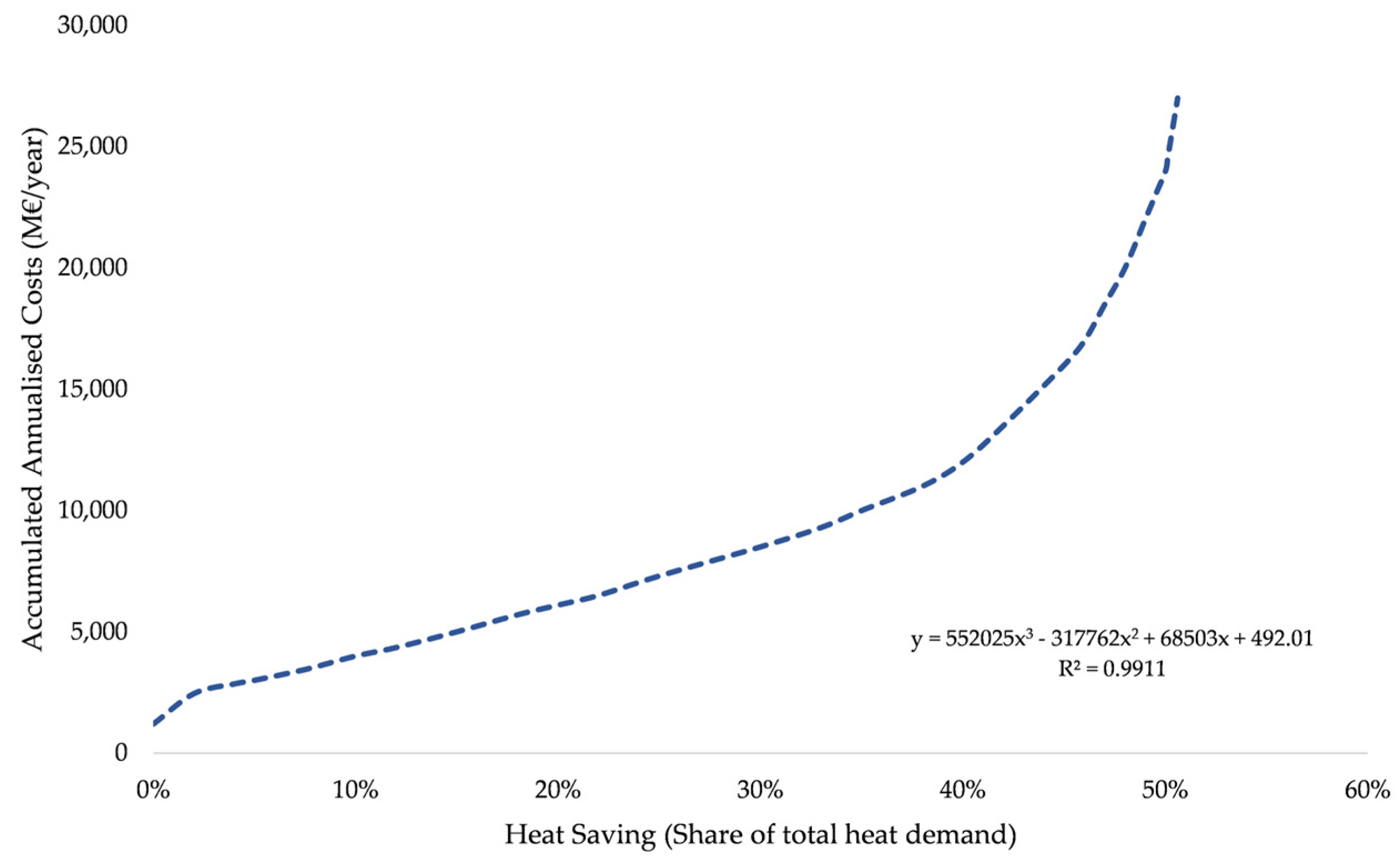
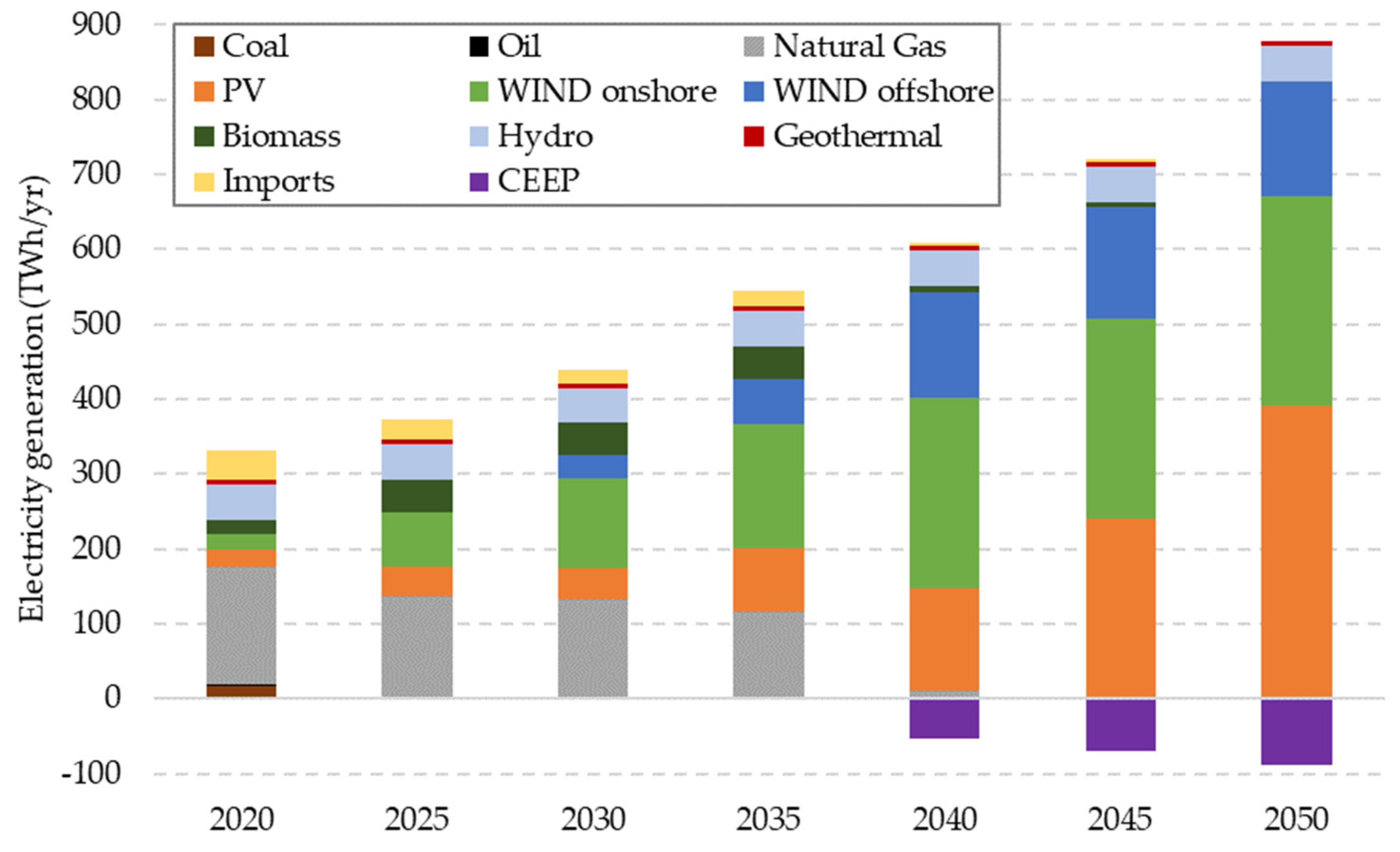
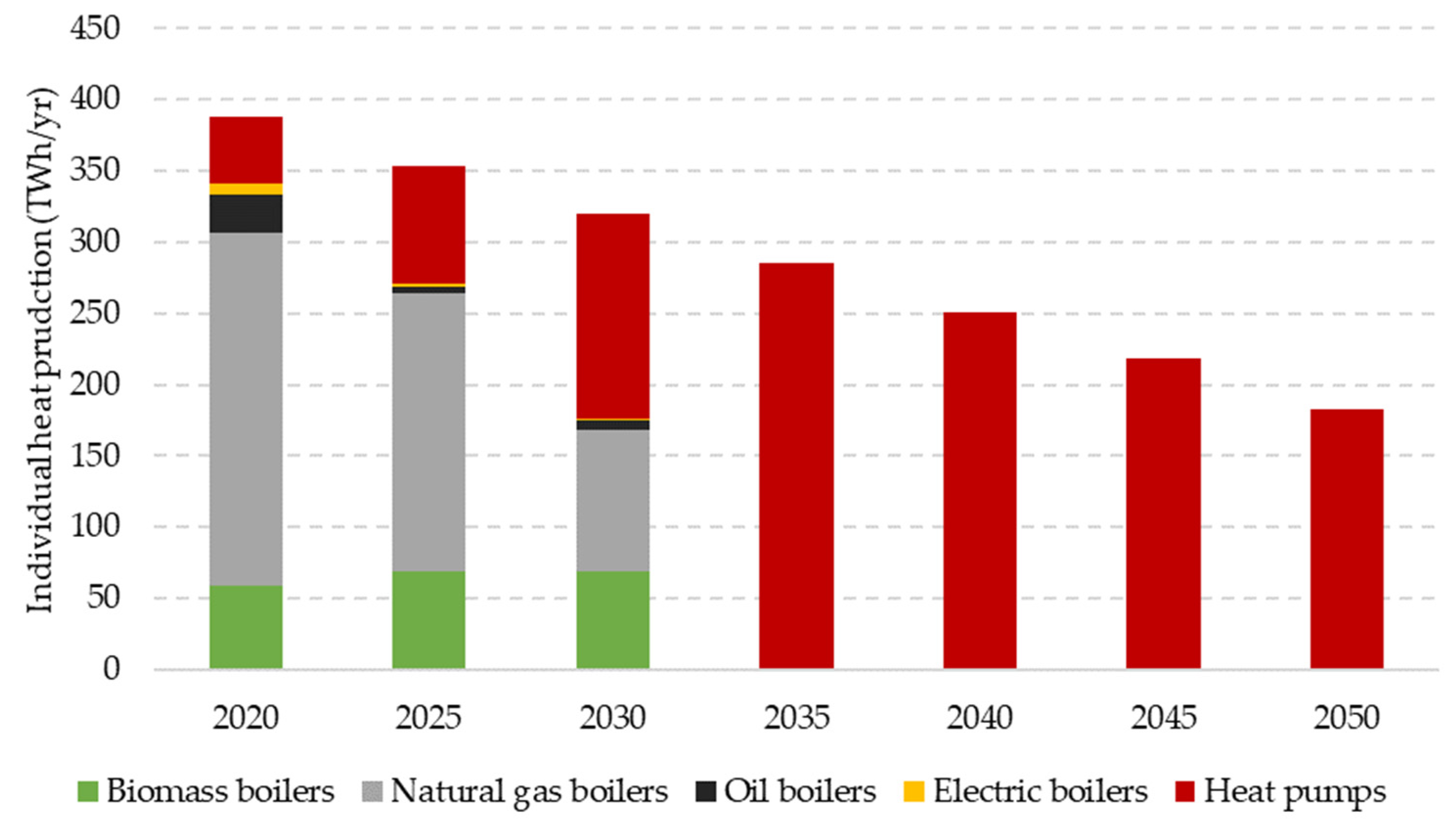
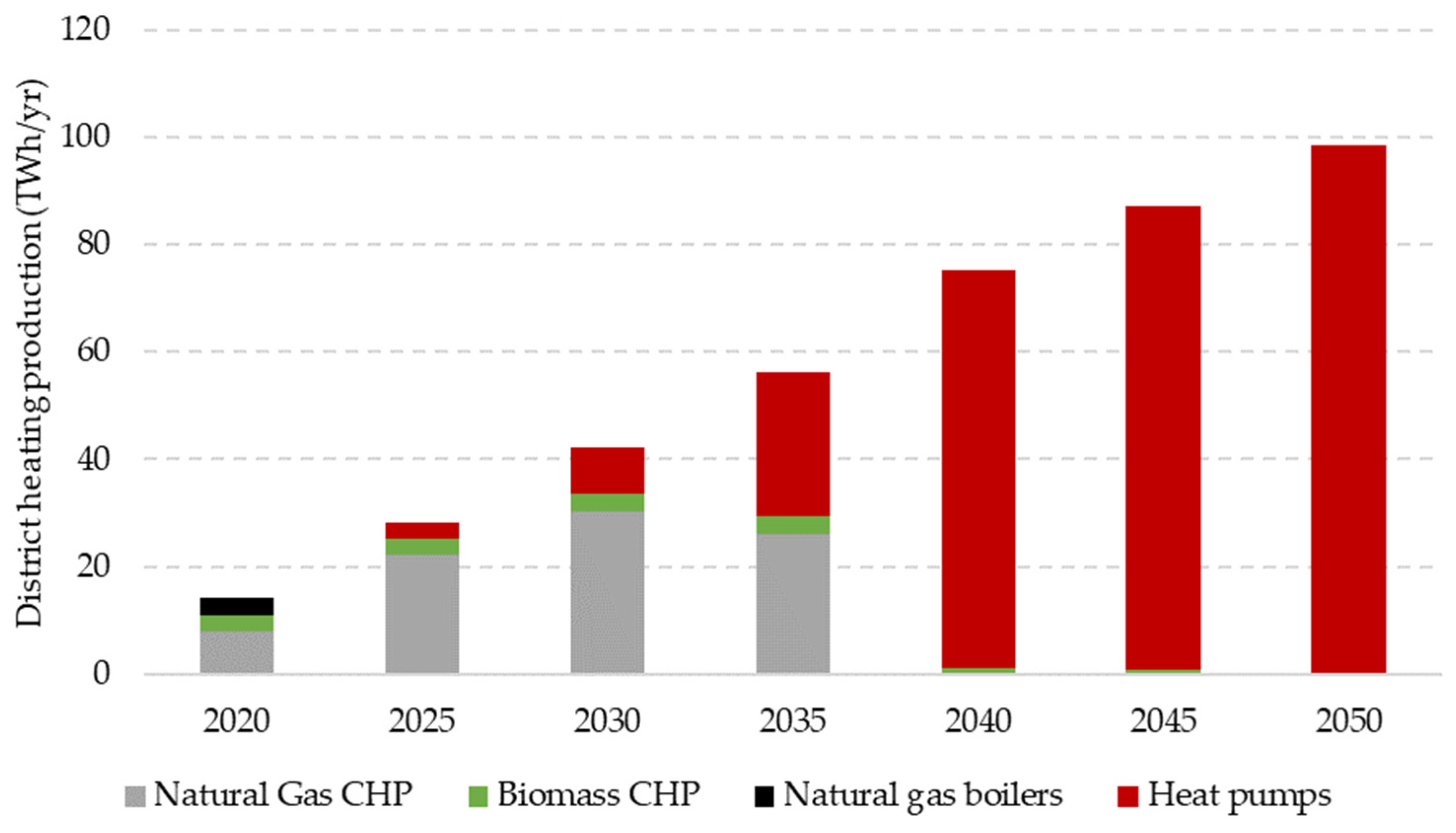
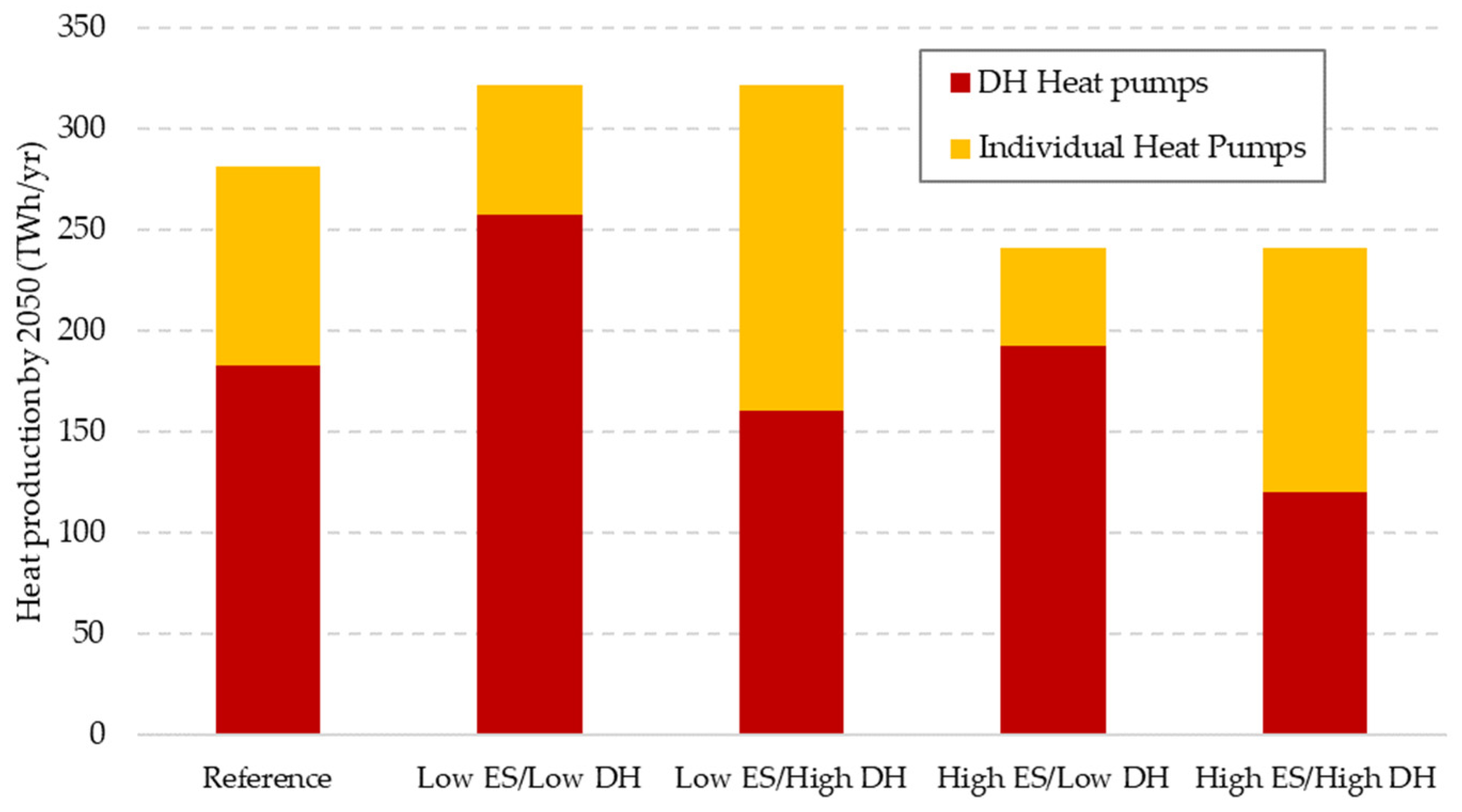
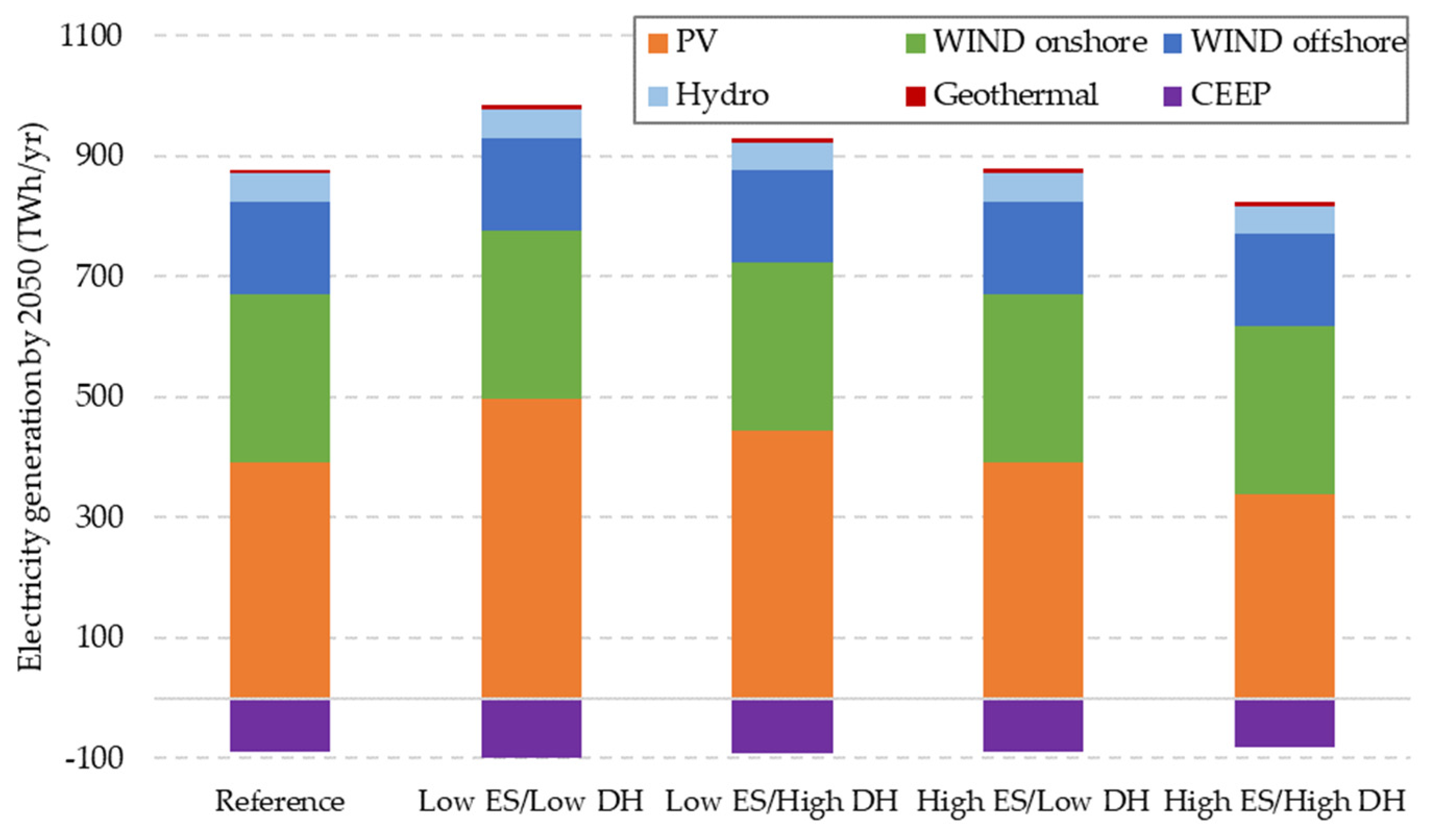
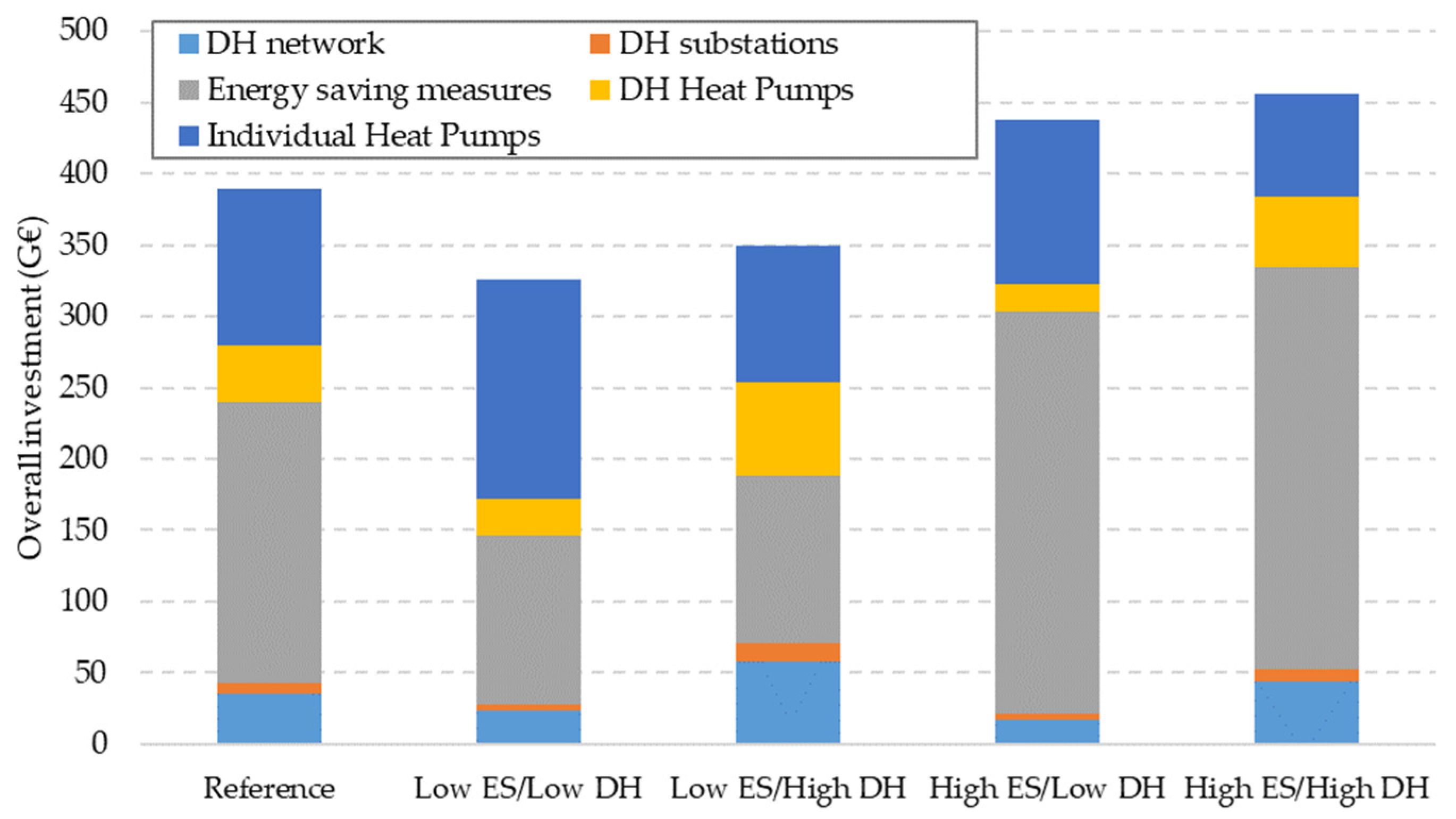
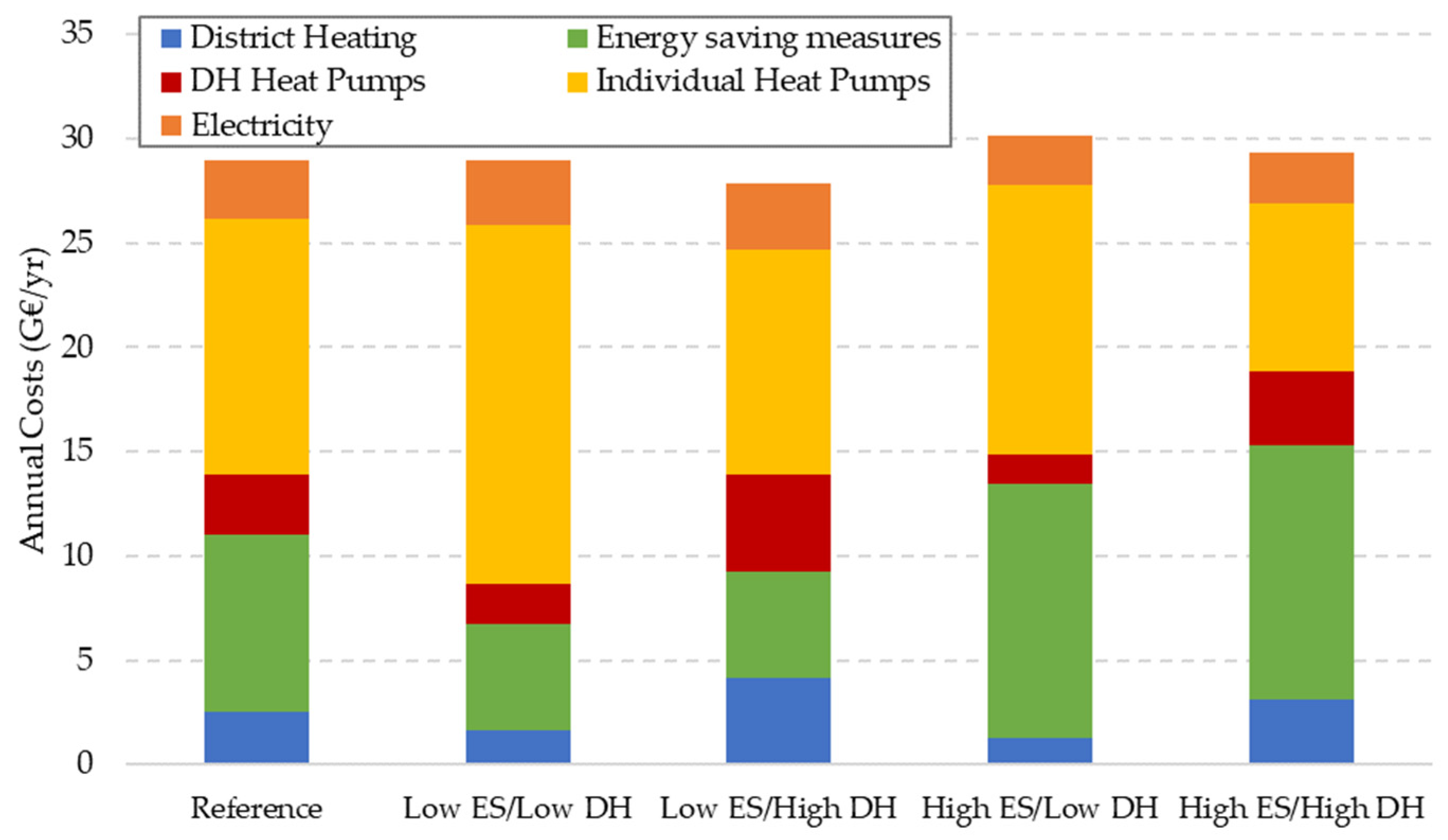
| Scenario | Share of Heat Demand Supplied by District Heating by 2050 | Heat Demand Reduction by Means of Energy-Saving Measures by 2050 |
|---|---|---|
| Reference | 35% | 30% |
| Low ES/Low DH | 20% | 20% |
| Low ES/High DH | 50% | 20% |
| High ES/Low DH | 20% | 40% |
| High ES/High DH | 50% | 40% |
Disclaimer/Publisher’s Note: The statements, opinions and data contained in all publications are solely those of the individual author(s) and contributor(s) and not of MDPI and/or the editor(s). MDPI and/or the editor(s) disclaim responsibility for any injury to people or property resulting from any ideas, methods, instructions or products referred to in the content. |
© 2024 by the authors. Licensee MDPI, Basel, Switzerland. This article is an open access article distributed under the terms and conditions of the Creative Commons Attribution (CC BY) license (https://creativecommons.org/licenses/by/4.0/).
Share and Cite
Pastore, L.M.; Groppi, D.; Feijoo, F. District Heating Deployment and Energy-Saving Measures to Decarbonise the Building Stock in 100% Renewable Energy Systems. Buildings 2024, 14, 2267. https://doi.org/10.3390/buildings14082267
Pastore LM, Groppi D, Feijoo F. District Heating Deployment and Energy-Saving Measures to Decarbonise the Building Stock in 100% Renewable Energy Systems. Buildings. 2024; 14(8):2267. https://doi.org/10.3390/buildings14082267
Chicago/Turabian StylePastore, Lorenzo Mario, Daniele Groppi, and Felipe Feijoo. 2024. "District Heating Deployment and Energy-Saving Measures to Decarbonise the Building Stock in 100% Renewable Energy Systems" Buildings 14, no. 8: 2267. https://doi.org/10.3390/buildings14082267






